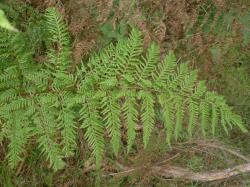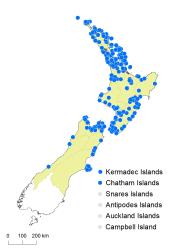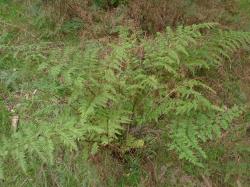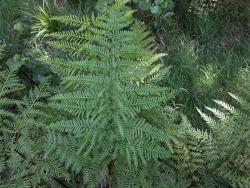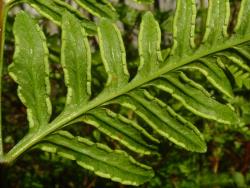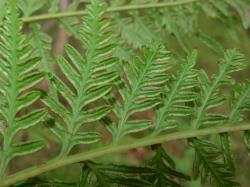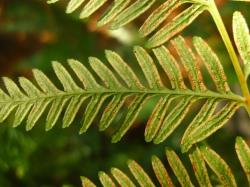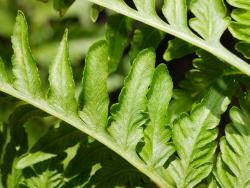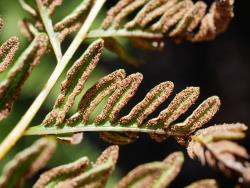- = Pteris affinis A.Rich., Essai Fl. Nouv.-Zél., 81 (1832)
- = Pteris tenuis A.Cunn., Companion Bot. Mag. 2: 365 (1837)
- ≡ Pteris tremula var. tenuis (A.Cunn.) Domin, Biblioth. Bot. 20(85): 156 (1913)
Rhizomes erect, scaly. Rhizome scales narrowly ovate, 2.5–9 mm long, 0.4–1 mm wide, golden brown, concolorous. Fronds 220–2440 mm long. Stipes 120–1170 mm long, red-brown proximally, yellow-brown or chestnut-brown distally, glabrous. Rachises green when young, darkening to chestnut-brown or yellow-brown, narrowly winged only in distal half, glabrous. Laminae deeply 2-pinnate-pinnatifid to deeply 3-pinnate-pinnatifid, 100–1270 mm long, 80–900 mm wide, ovate, mid-green adaxially, yellow-green abaxially, herbaceous or coriaceous, glabrous or with minute hairs along costae. Primary pinnae in 5–18 pairs below pinnatifid apex, not or slightly overlapping; the longest at or near base, 60–620 mm long, 42–240 mm wide, broadly ovate or ovate or narrowly elliptic, straight; pinna apices acute or acuminate, bases stalked. Longest secondary pinnae 23–215 mm long, 10–120 mm wide, ovate, sub-opposite; apices acute, bases short-stalked; basiscopic secondary pinnae on basal primary pinnae elongated. Longest tertiary segments 5–70 mm long, 2–35 mm wide, ovate to linear; apices acute to obtuse, margins entire, bases adnate or short-stalked; sometimes divided into quaternary segments 4–20 mm long, 1–4 mm wide, linear to oblong; apices obtuse, margins entire or shallowly serrate, bases adnate. Veins free. Sori continuous along sides of the ultimate segments.
Pteris tremula is distinguished by its erect rhizome, 2-pinnate-pinnatifid to almost 4-pinnate laminae, free veins, herbaceous texture, long narrow ultimate segments, and laminae lacking scales but sometimes with minute hairs along the costae. It is more divided, with more pairs of primary pinnae, than most other species in New Zealand. It could be confused with P. epaleata in overall morphology but differs significantly in having free veins rather than anastomosing venation.
North Island: Northland, Auckland, Volcanic Plateau, Gisborne, Taranaki, Southern North Island.
South Island: Western Nelson, Sounds-Nelson, Marlborough, Westland, Canterbury.
Kermadec Islands, Three Kings Islands, Chatham Islands.
Altitudinal range: 0–550 m.
Pteris tremula occurs on the Kermadec Islands, Three Kings Islands, and in coastal and lowland areas of the North Island from Te Paki to Wellington, extending locally into montane districts. It is absent only from parts of the central North Island and Gisborne high country. It grows from near sea level, reaching 550 m in the Kāweka Ranges. In the South Island it occurs from north-west Nelson to the Marlborough Sounds, south to Banks Peninsula on the east coast, and to Punakaiki on the west coast, with an outlying population at the Paringa River mouth in south Westland. It reaches almost 250 m on Mt Burnett. It also occurs on the Chatham Islands.
Also Australia (Northern Territory, South Australia, Queensland, New South Wales, Australian Capital Territory, Victoria, Tasmania), Norfolk Island, Lord Howe Island, Vanuatu and Fiji. Widely cultivated internationally; naturalised in southern Africa and California (Crouch et al. 2011), parts of the Northern Hemisphere (Zhang et al. 2015), and in Tamil Nadu State, India (Fraser-Jenkins et al. 2017).
Pteris tremula is found under coastal forest and scrub, open broadleaved and beech forest, kānuka and mānuka scrub, and in open pine plantations. It also occurs on forest margins, under regenerating scrub, in reverting pasture, on wooded sand-dunes, at the base of cliffs, and as a weed in gardens. It favours streambanks, the base of waterfalls, river terraces, bush clearings, open forest floor, roadside banks, rocky hillsides, and swamp margins. It occurs on greywacke, limestone and scoria. It is sometimes common in heavily grazed areas because the fronds are unpalatable to stock.
Pteris tremula is not known to hybridise with any other species in New Zealand.
n = c. 120 (Brownlie 1957).
Pteris novae-zelandiae was described by Field (1906) from material received in a “parcel of ferns from Waikanae”. He compared it with P. tremula but noted that it differed most obviously in its growth form – spreading horizontally by the production of lateral fronds, rather than being erect. No original material has been located and it is impossible to determine the identity of the plant from the description alone. The name was not documented by either Cheeseman (1925) or Allan (1961) and, in any case, was not validly published because Field stated only that “it may be provisionally named Pteris novae-zelandiae”. Provisional names are not considered to be validly published (see Art. 36.1, Ex. 5).



